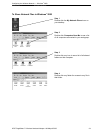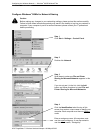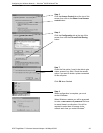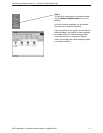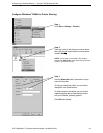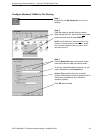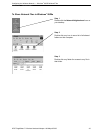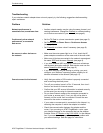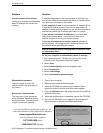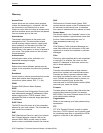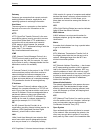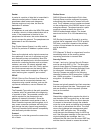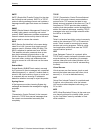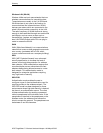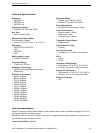
Glossary
AT&T Plug&Share™ Wireless Notebook Adapter 108 Mbps 6750G 34
Gateway
Gateways are computers that convert protocols
enabling different networks, applications, and
operating systems to exchange information.
Host Name
The name given to a computer or client station
that acts as a source for information on the
network.
HTTP
HTTP (HyperText Transfer Protocol) is the com-
munications protocol used to connect to servers
on the World Wide Web. HTTP establishes a
connection with a web server and transmits
HTML pages to client browser (for example
Windows
®
IE). HTTP addresses all begin with the
prefix “http://” (for example,
http://www.somedomainname.com).
ICMP
ICMP (Internet Control Message Protocol) is a
TCP/IP protocol used to send error and control
messages over the LAN (for example, it is used
by the router to notify a message sender that the
destination node is not available).
IP
IP (Internet Protocol) is the protocol in the TCP/IP
communications protocol suite that contains a
network address and allows messages to be
routed to a different network or subnet. However,
IP does not ensure delivery of a complete message;
TCP provides the function of ensuring delivery.
IP Address
The IP (Internet Protocol) address refers to the
address of a computer attached to a TCP/IP net-
work. Every client and server station must have a
unique IP address. Clients are assigned either a
permanent address or have one dynamically
assigned to them via DHCP. IP addresses are
written as four sets of numbers separated by
periods (for example, 211.23.181.189).
ISP
An ISP (Internet Service Provider) is an
organization providing Internet access service via
modems, ISDN (Integrated Services Digital
Network), private lines or other means.
LAN
LANs (Local Area Networks) are networks that
serve users within specific geographical areas,
such as your home or in a company building.
LANs consist of a group of computers and related
devices that share a common communication link
(wired and/or wireless). A LAN allows you to
share data and resources among the devices on
the LAN.
LED
LEDs (Light Emitting Diodes) are used as indicator
lights to show the status of devices.
MAC Address
A MAC address is a unique serial number for
hardware adapters, giving the adapter a unique
identification.
Metric
A number that indicates how long a packet takes
to get to its destination.
MTU
MTU (Maximum Transmission/Transfer Unit) is
the largest packet size that can be sent over a
network. Messages larger than the MTU are
divided into smaller packets.
NAT
NAT (Network Address Translation — also known
as IP masquerading) enables a LAN to present
itself to the Internet with one address. NAT con-
verts the address of each LAN node into one IP
address for the Internet (and vice versa). NAT also
provides a certain amount of security by acting as
a firewall by keeping individual IP addresses
hidden from the WAN.
Network Administrator
The network administrator is the person who man-
ages the LAN. The administrator's tasks include
ensuring network security, keeping software, hard-
ware, and firmware up-to-date, and keeping track
of network activity.
NTP
NTP (Network Time Protocol) is used to synchro-
nize the realtime clock in a computer. Internet pri-
mary and secondary servers synchronize to
Coordinated Universal Time (UTC).
Open System
Open authentication allows all clients to connect
to the network. After accessing the network, the
client may encrypt data to prevent it from being
easily seen by other users in the immediate area.



